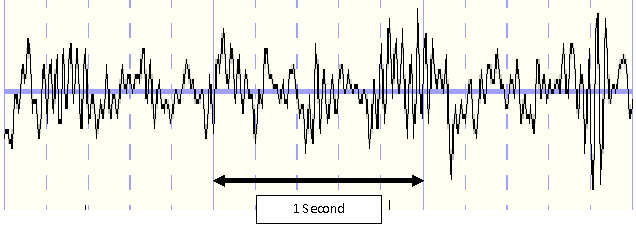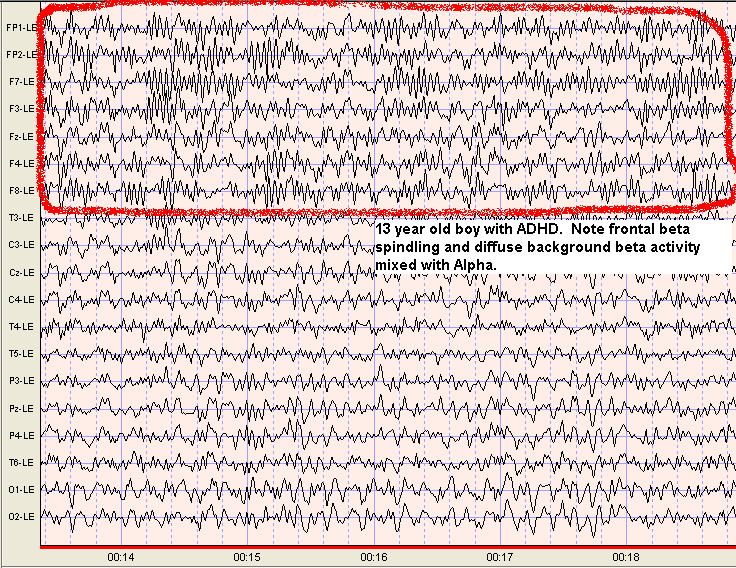Beta Waves
Normal Occurrence of Beta Waves
- Beta waves oscillate between about 13 and 35 times per second.
- Beta waves are prominent during states of concentration and problem solving.
- Beta waves are common in the EEG’s of most waking adults but may also be present during drowsiness.
- Beta waves tend to be more visible in the EEG when the patients eyes are open.
Abnormal Occurrence of Beta Waves
- Beta asymmetries are usually pathological over the side with reduced amplitude, especially if the asymmetry is greater than 50%. However, other frequency asymmetries should be considered before determining abnormality (is there also reduced Alpha / increased Theta, etc.).
- Interhemispheric Beta Asymmetries can be due to remote infarcts or subdural collections (bruises, swelling, etc.).
- Bi-laterally increased Beta can be due to previous craniotomy (Breech Rhythm).
- Elevated Beta amplitudes in posterior leads is more unusual than Beta in central / frontal leads.
- Lack of Beta desynchronization with difficult tasks may be abnormal.
- Spindling Beta generally reflects increased cortical irritability and is most likely seen in clinical conditions such as…
- ADHD
- Epilepsy
- Psychoses including during hallucinations
- Anxiety disorders
- Excessive Beta activity on quantitative analysis can relate to symptoms of brain over arousal such as anxiety, obsessiveness, sleep difficulties, hyperactivity, etc.
- Deficient Beta activity on quantitative analysis can relate to symptoms of brain under aroused such as difficulty concentrating, problem solving, etc.
Physiological Origin of Beta Wave Rhythms
Two Types of Beta Rhythms- Sensory-Motor Beta (Rolandic) is localized to the motor strip (center of the head) but distinct in morphology, speed, & location from Mu rhythm. It has peak frequency @ 20Hz. It becomes less rhythmic with motor action or motor planning and more rhythmic following motor actions. Sensory-motor Beta reflects the resting and resetting of the motor system following information processing. The more frequently Beta rhythms synchronize (the faster the rhythm) the more excitable the cortex (surface of the brain).
- Frontal Beta is localized to front of the head and it is composed of irregular rhythms generally less than 20 Hz. Frontal Beta tends to become more rhythmic and synchronized several hundred ms post-processing of stimuli that require assessment, cognitive evaluation, and decision making. This synchronization may be preceded by Beta desynchronization. The amount of frontal Beta desynchronization and rebound synchronization in response to a cognitive task is proportional to the difficulty of the task. Increasing Task Difficulty = Increased Beta Desynchronization.
Role of Beta Waves in Having a Healthy Brain
- Beta Power (and Alpha Power) is a good indicator of how much activity and metabolism is occurring in your brain.
- Beta tends to become less rhythmic when you are concentrating on something that is mentally challenging. This correlates with increased blood oxygenation and metabolism in the brain.
- Some neurofeedback seeks to increase Beta in the 12-18 Hz range or to reduce the Theta / Beta ratio to aid in attention.
- NFB to inhibit excessive Beta can be helpful in reducing anxiety, OCD, and the high beta subtype of ADHD.
Images of Beta Waves
Single channel; 19 Channel: Linked Ear Montage;
13 year old Male with Beta Phenotype / Subtype of ADHD. Examples Highlighted in Red
19 Channel: Linked Ear Montage;
13 year old Male with Beta Phenotype / Subtype of ADHD. Examples Highlighted in Red

Click here to learn about Delta Waves >>>>>>>>>>>>>>>>>>>>>>>>
EEG Brainwaves
Beta Waves
- Beta Waves
- Normal Occurrence of Beta Waves
- Abnormal Occurrence of Beta Waves
- Physiological Origin of Beta Wave Rhythms
- Role of Beta Waves in Having a Healthy Brain
- Images of Beta Waves
For more information, or to schedule an appointment, call us on 480-625-4123
Contact
- 8114 E. Cactus Rd - Suite 200, Scottsdale, AZ, 85260
- +1 480 625 4123